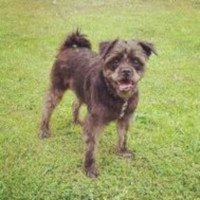Appearance of the Schnug
|
| The Schnug is a rather unusual-looking dog that couldn't be described as handsome in the classical sense. With a relatively small skull and short muzzle, as well as large, round eyes, they have a rather unique look. Add to this a wavy coat that can look unkempt, and you have a distinctive dog. As with their parent breeds, Schnugs have semi-erect triangular ears that tilt towards the front of the head. Their body is long and, although their limbs are longer than those of the Pug, they cannot be described as long. The Schnug's tail can be straight, but often folds over the back like that of the Pug. The Schnug's coat can be short or medium length, and the fur is straight. While some will retain the Schnauzer's distinctive beard and moustache, others will not. It's common for dogs to wear a dark face mask or at least a dark muzzle, although this isn't true for all individuals. Many will have the classic fawn-colored Pug coat, although their fur can also be brown, gray or black. A fully developed Schnug will reach heights of 25 to 36 cm and weights of 7 to 11 kg, with the female often considerably smaller than the male. |
Temperament of the Schnug
|
| Although the Schnug's appearance may not appeal to everyone, their personality is virtually flawless. Happy, sweet and gentle little dogs, Schnugs really shine as pets. Although they can be both curious and mischievous, they're too eager to please to be described as truly naughty or troublesome. Happiest playing with their owners and in the company of children, Schnugs enjoy most people's company, although it can take some time to open up to new people. As these dogs are highly dependent on human companionship, they should not be left alone at home all day. Always alert and on the lookout for anything that might happen, the Schnug will immediately alert its owner to any newcomer with a loud, persistent bark. Although they rarely act aggressively or hostile to an intruder, their incessant barking can be enough to drive them away. Outgoing and sociable with people and other animals, the Schnug likes to make friends with dogs of all shapes and sizes, and is often the most popular dog in the dog park. Although they can coexist with cats if introduced when young, they have retained some of their prey drive and should not mix with smaller animals, such as rabbits or gerbils. |
Needs and activities of the Schnug
|
| The Schnug is a small dog with a lot of energy, but it's not excessive. They will need a daily walk to keep fit and to enable socialization with other dogs and people, an important part of their development. They are best kept on a leash, as they have a fairly high hunting instinct and can take off after small animals, regardless of your repeated calls to stop him. These social loving dogs will also enjoy time running free with other dogs in secure dog parks. They'll love a selection of toys to play with, and adore family games or a well-defined task that will challenge their inquisitive nature. But if the activity suits them, they'll also want to spend time with you. This means your lap will be considered theirs, and they'll snuggle up to you at every opportunity. The Schnug is a dog that will also be at home in an apartment or house with a small yard. They're indoor dogs, so they'll be shocked if you suggest they sleep outside in a kennel, and will protest loudly if you try to do so. If you don't want a dog in the house, then this isn't the dog for you. They want to be glued to your side and become part of your life, and will entertain the family with their friendly nature. |
Maintenance of the Schnug
|
| The Schnug is relatively easy to care for, simply brushing every few days to keep their coat healthy and braid-free. A stiff bristle brush or comb will even out the coat and remove dead hairs. When bathing your dog, be sure to use a special dog shampoo that's gentler on the skin and preserves the coat's natural oils and weather resistance. Training young puppies to accept brushing will save problems later on. Simply start with short sessions to familiarize them with this new procedure. Another area to check is the ears, where dirt and wax can build up and become infected, leading to all sorts of health problems. Gently clean the inside of the ear with a soft, damp cloth, then dry the area to keep it healthy. Your Schnug's nails may need trimming if they're too long, but a light trim once a month should be enough to keep them at the right length. Most dogs enjoy the grooming process. It's the ideal time to look for sores or infections, because dogs never complain when they're in pain - they keep it to themselves. Taking the time to groom your pet dog will be appreciated by them, and they'll get all the attention. |









 English (United Kingdom)
English (United Kingdom)